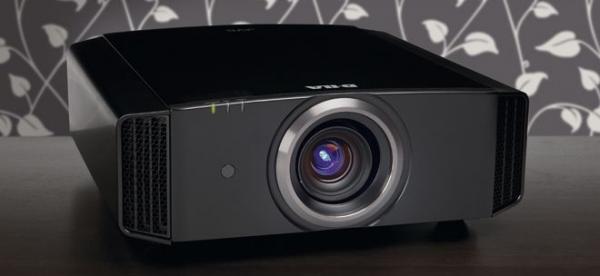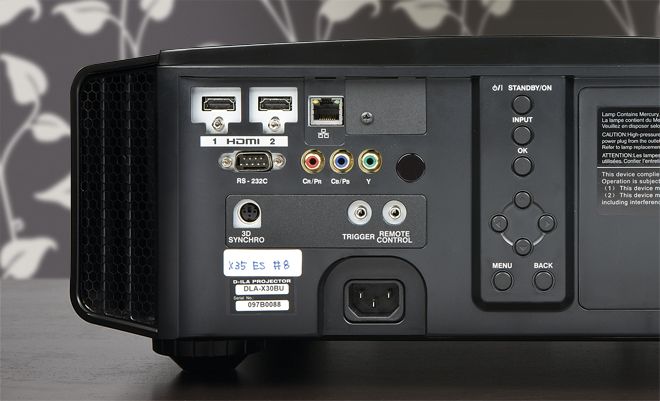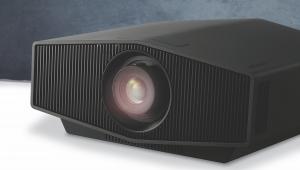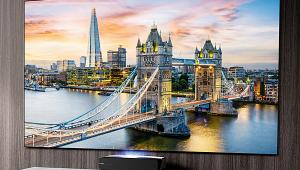JVC DLA-X35 review

It says much that JVC’s entry-level projector comes in where other brands' high-end offerings sign off. Priced at £2,900, it looks a veritable bargain when viewed alongside the company's £10,000 bespoke DLA-X95R flagship.
Not that there’s an awful lot to suggest that the DLA-X35 is a budget proposition. For starters, it’s beautifully built with a substantial chassis that tips the scales at just under 15kg. It’s a large beast too, some 455mm wide and 472mm deep. Both factors conspire to make this a serious install. The projector is just too big to be used as a special occasion pull-out. As with last year’s lookalike DLA-X30 offering, there’s a choice of black or white cabinet finishes. If the standard remote control isn’t to your liking, JVC also offers a smartphone app. Its principal competition comes in the form of the Sony VPL-HW50ES, and, to a lesser extent, Panasonic's PT-AT6000E and Epson's EH-TW9100.
Now supporting RF 3DConnectivity comprises two HDMIs, component and PC VGA inputs, plus Ethernet, RS232 and a 12V trigger. Ethernet is only used for control and not content delivery, while the trigger is used to sync the projector with electric screens. The projector is also 3D compatible. This year JVC has embraced RF active shutter glasses, which make for a far more practical solution that last season’s separate IR blaster. Supplied in the box is an RF Syncro Emitter (PK-EM2) which plugs into the rear of the unit. You can still use the projector with previous IR 3D eyewear, but it’s not possible to mix and match IR with RF shuttering systems. Also bundled are two pairs of PK-AG3 RF active shutter glasses.
The DLA-X35 offers a variety of setup and calibration options. A 2x motorised zoom lens and integrated test pattern makes short work of sizing and focus; there’s also 80 per cent vertical and 34 per cent horizontal lens shift available. A five-mode Lens Memory function helps accommodate various screen ratios when using a CinemaScope ratio screen; for example, you can use one position to set 16:9 ratio content to give full height with black bars left and right, another to memorise zoomed ‘Scope images to correctly fill height and width, and a third to accommodate ‘Scope movies with captions. Each lens memory can be renamed to simplify operation. The JVC also boasts a dedicated anamorphic mode, should you want to use it with an optional lens.
Beneath the hood, the DLA-X35 utilises a 0.7in Full HD D-ILA imaging device and NSH 230W lamp for which JVC quotes a life of 4,000 hours. As with last year’s model, brightness is rated at 1,300 lumens and native contrast ratio set at 50,000:1. It’s worth remembering that rival imaging technology needs to use a dynamic iris to get anywhere near that number.
Up and runningOnce installed and calibrated, the most immediate impression is one of eerie silence. This bigscreen hero is whisper-quiet. JVC quotes 23dB with the lamp in its Eco Low mode, and it really does disappear when you factor in the noise from a home cinema system. Although the brightness spec may seem a tad low, the projector is perky enough to run on the low lamp setting without incurring any visual penalties. The huge dynamics of its images ensure a lively sparkle regardless.
The projector’s throw will suit most typical UK living room spaces. A 100in diagonal 16:9 image can be thrown from 3.01m (wide), with 120in cast in 3.62m (wide). Larger home theatres require between 6.06m (wide) and 12.30m (tele) to craft a 200in picture.
The key technical difference between the DLA-X35 reviewed here and the step-up DLA-X55R is the lack of 4K e-shift technology. Despite marketing hyperbole, none of JVC’s fleet is actually 4K capable – the e-shift process is entirely optical. An additional lens is placed between the D-ILA device and the projection lens, which produces an offset subframe of the original image, thereby theoretically doubling both the vertical and horizontal resolution.
It's this that JVC claims as a 3,840 x 2m160 resolution projected image. I suspect that after auditioning the DLA-X35 you’ll find it difficult to justify spending an additional £2,000 for such visual sleight of hand (the DLA-X55R does proffer additional more sophisticated picture processing modes, but the observation still stands).

The simple fact is the DLA-X35 is an astonishingly good performer regardless, offering rich, cinematic images. JVC continues to set a benchmark when it comes to black level performance and dynamics, one that other brands struggle to match. The amount of shadow detail and depth available is considerable. When the Black Widow is being tortured at the opening of Avengers Assemble, you can stare deep into the shadowy recesses of the warehouse, giving the sequence a three-dimensional feel without recourse to any funny glasses. Greyscale tracking is excellent. A 20/20 black-to-white test chart looked superb, while colour gradations are velvety smooth.
2D image sharpness is equally considerable; textures and fine detail zing from Blu-ray and broadcast HD sources alike, particularly when you utilize (sparingly) the Detail Enhance tool. The DLA-X35 features a 120Hz Clear Motion Drive, which does a reasonable job with motion resolution, minimizing blur without overcooking the video sheen characteristic of faster refresh rates.
There’s a real visceral pop to its colour performance, which is a particular delight with animation. There are three colour space modes: Off (which delivers the source without adjustment), Standard (which complies to the HDTV specification) and Wide (which reflects the DCI standard). There’s also a highly precise red and blue Pixel Adjust mode to dial out any unwanted colour fringing in the image. Test footage of artfully-lit brass instruments and varnished violins looks beautiful. The metallic sheen of the horns glints realistically, while the lustre of the violins hints at expensive musicality.
The projector’s 3D performance is a tad less satisfactory, in so much that it’s still susceptible to double imaging – although there is crosstalk cancellation offered to mitigate against this. If you don’t let the effect disturb you too much, there’s plenty of immersive depth to revel in and screen brightness doesn’t suffer as the projector’s Frame Addressing driver technology cranks up to compensate. The good news is that the brand’s new glasses are light and comfortable to wear. USB rechargeable, they come with enough juice for around 40 hours.
JVC’s professional division actually supplies a pro-grade 2D-to-3D processor for content mastering and some of that expertise can be found in the DLA-X35’s 2D-to-3D conversion technology. Generally this is best steered clear of, but if you own a 2D version of a movie made for 3D, you’ll get passable results.
Superior performerOverall, the DLA-X35 can be deemed a superior projector capable of a high level of performance. Image quality is first-rate and there’s considerable fine-tuning on offer. It also runs agreeably quietly. That said, this is not a model suitable for relatively well-lit rooms - if you’re looking for a model for sports and gaming social events, then there are more suitable (and smaller) light canons available. However, if you’re building a kickass home cinema, this JVC offers a stunning level of performance for the cash.
HCC VERDICT
 JVC DLA-X35
JVC DLA-X35
Price: £2,900 Approx
www.jvc.co.uk
Highs: Outstanding Full HD image quality; low operational noise; versatile setup and calibration options; RF 3D system
Lows: Bulky; 3D suffers from crosstalk double imaging
Performance: 4.5/5
Design: 4/5
Features: 4/5
Overall: 4.5/5
 |
Home Cinema Choice #351 is on sale now, featuring: Samsung S95D flagship OLED TV; Ascendo loudspeakers; Pioneer VSA-LX805 AV receiver; UST projector roundup; 2024’s summer movies; Conan 4K; and more
|























































